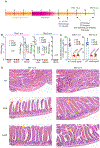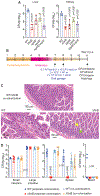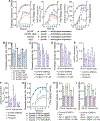Enterococcal bacteremia in mice is prevented by oral administration of probiotic Bacillus spores
- PMID: 34818053
- PMCID: PMC11097119
- DOI: 10.1126/scitranslmed.abf4692
Enterococcal bacteremia in mice is prevented by oral administration of probiotic Bacillus spores
Abstract
Whether and how probiotics promote human health is a controversial issue. Their claimed benefit for counteracting gastrointestinal infection is linked predominantly to reducing pathogen abundance within the intestinal microbiota. Less understood mechanistically is the reported value that probiotics could have in reducing systemic infections. Enterococcus faecalis is an opportunistic pathogen that causes systemic infection after translocation through the intestinal epithelium, particularly in hospitalized and immune-depleted patients receiving antibiotic therapy. In this study, we used an E. faecalis mouse infection model with wild-type and isogenic mutant strains deficient in genes of the E. faecalis Fsr (fecal streptococci regulator) quorum-sensing system. We show that E. faecalis translocation from the mouse gut into the blood is mediated by the Fsr quorum-sensing system through production of the protease GelE, which compromises intestinal epithelium integrity. Furthermore, we demonstrate that orally administered probiotic Bacillus subtilis spores blocked E. faecalis translocation from the gut to the bloodstream and subsequent systemic infection in mice by inhibiting Fsr activity. These findings demonstrate that a key aspect of Enterococcus pathogenesis is controlled by quorum sensing, which can be targeted with probiotic Bacillus spores.
Conflict of interest statement
Figures








Similar articles
-
Probiotic Bacillus Affects Enterococcus faecalis Antibiotic Resistance Transfer by Interfering with Pheromone Signaling Cascades.Appl Environ Microbiol. 2021 Jun 11;87(13):e0044221. doi: 10.1128/AEM.00442-21. Epub 2021 Jun 11. Appl Environ Microbiol. 2021. PMID: 33893118 Free PMC article.
-
The Fsr quorum-sensing system of Enterococcus faecalis modulates surface display of the collagen-binding MSCRAMM Ace through regulation of gelE.J Bacteriol. 2011 Sep;193(17):4317-25. doi: 10.1128/JB.05026-11. Epub 2011 Jun 24. J Bacteriol. 2011. PMID: 21705589 Free PMC article.
-
The fsr Quorum-Sensing System and Cognate Gelatinase Orchestrate the Expression and Processing of Proprotein EF_1097 into the Mature Antimicrobial Peptide Enterocin O16.J Bacteriol. 2015 Jul;197(13):2112-2121. doi: 10.1128/JB.02513-14. Epub 2015 Mar 2. J Bacteriol. 2015. PMID: 25733609 Free PMC article.
-
Molecular Mechanism of Quorum-Sensing in Enterococcus faecalis: Its Role in Virulence and Therapeutic Approaches.Int J Mol Sci. 2017 May 3;18(5):960. doi: 10.3390/ijms18050960. Int J Mol Sci. 2017. PMID: 28467378 Free PMC article. Review.
-
Probiotics to prevent Staphylococcus aureus disease?Gut Microbes. 2020;11(1):94-101. doi: 10.1080/19490976.2019.1591137. Epub 2019 Mar 26. Gut Microbes. 2020. PMID: 30913972 Free PMC article. Review.
Cited by
-
Assembly of functional microbial ecosystems: from molecular circuits to communities.FEMS Microbiol Rev. 2024 Nov 23;48(6):fuae026. doi: 10.1093/femsre/fuae026. FEMS Microbiol Rev. 2024. PMID: 39496507 Free PMC article. Review.
-
Probiotics in piglet: from gut health to pathogen defense mechanisms.Front Immunol. 2024 Nov 4;15:1468873. doi: 10.3389/fimmu.2024.1468873. eCollection 2024. Front Immunol. 2024. PMID: 39559358 Free PMC article. Review.
-
Promiscuous, persistent and problematic: insights into current enterococcal genomics to guide therapeutic strategy.BMC Microbiol. 2024 Mar 28;24(1):103. doi: 10.1186/s12866-024-03243-2. BMC Microbiol. 2024. PMID: 38539119 Free PMC article. Review.
-
Effects of Probiotics on Gut Microbiota: An Overview.Int J Mol Sci. 2024 May 30;25(11):6022. doi: 10.3390/ijms25116022. Int J Mol Sci. 2024. PMID: 38892208 Free PMC article. Review.
-
Remodeling of the Enterococcal Cell Envelope during Surface Penetration Promotes Intrinsic Resistance to Stress.mBio. 2022 Dec 20;13(6):e0229422. doi: 10.1128/mbio.02294-22. Epub 2022 Nov 10. mBio. 2022. PMID: 36354750 Free PMC article.
References
-
- Sanders ME, Merenstein DJ, Reid G, Gibson GR, Rastall RA, Probiotics and prebiotics in intestinal health and disease: from biology to the clinic. Nat Rev Gastroenterol Hepatol 16, 605–616 (2019). - PubMed
-
- Saxelin M, Tynkkynen S, Mattila-Sandholm T, de Vos WM, Probiotic and other functional microbes: from markets to mechanisms. Curr Opin Biotechnol 16, 204–211 (2005). - PubMed
-
- van Baarlen P, Wells JM, Kleerebezem M, Regulation of intestinal homeostasis and immunity with probiotic lactobacilli. Trends Immunol 34, 208–215 (2013). - PubMed
Publication types
MeSH terms
Substances
Grants and funding
LinkOut - more resources
Full Text Sources

